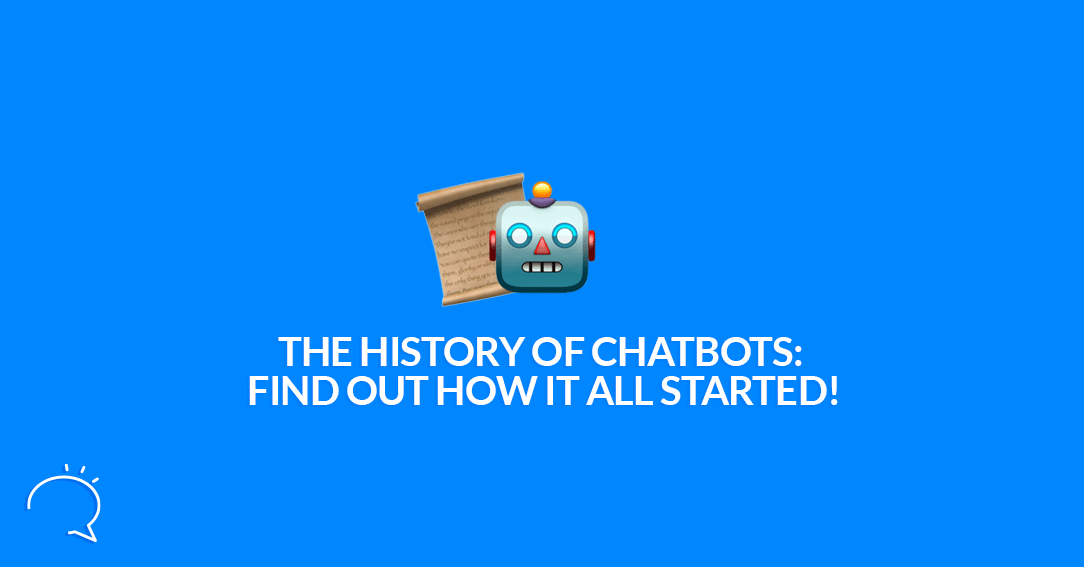Have you ever wondered how chatbots started? Let’s take a trip down memory lane and get to know the history of chatbots. Communicating with customers has come a long way. The customer support industry saw its first fundamental significant changes in the 19th century when Alexander Graham-Bell’s invention of the electric telephone came about. This has allowed businesses to provide information to customers, even from long-distance. It went on until the emergence of the call center industry in the 1960s. Fast forward till today, and you see that various innovations in sales and customer support include chatbots.
We asked ourselves: “Wouldn’t it be amazing to discover how it all started?”
We thought this would be an excellent question to ask. Mainly because understanding how we got here will help us better figure out where things are going. Plus, what we should expect from this technology in the future!
The history of chatbots is a fascinating topic to explore. It’s only been in the last few years that they have become more than just something for our imagination. Did you know that the word “chatbot” can be traced back to the 1950s? Their history goes even much further back than that.
Let’s travel back in time to get to know the story of chatbots. Aside from the timeline itself, you will also take a glimpse of chatbot platforms across time.
History Of Chatbots
Chatbots are not as old as the other customer service systems. The chatbots we know today are still considered fresh and young. That said, let’s start with the first chatbot in our little time-traveling experiment here.
The 1960s With The World’s First Chatbot, ELIZA
In the 1960s, Joseph Weizenbaum created a program called Eliza. This chatbot was designed to imitate human interaction and responded with phrases of its own that seemed intelligent. It would address questions about psychotherapy leading people into believing it is a natural person talking back to them. In reality, it’s just an algorithm programmed by Weizenbaum, who wanted to test how much humans can be fooled by computers in conversations where intelligence isn’t required or expected, like on social media sites such as Facebook Messenger.
ELIZA utilizes a template-matching algorithm to simulate conversations – one of the earliest forms of artificial intelligence. ELIZA’s prompts involve scripted responses that passed the Turing artificial intelligence test. Created by Alan Turing in the 1950s, the Turing test challenged the machine’s ability. It found out whether it can exhibit intelligent behavior comparable with human beings.
On its basis, this ELIZA program mimicked human chats. It worked by passing the words a user entered into a computer. Afterward, it paired these to a list of possible scripted responses. The program would choose a reply based on the words and sentence structure.
1972: PARRY
The story of the chatbots across time continues with PARRY, a system created in the 1970s. Unlike ELIZA, PARRY was able to understand and react with natural language. PARRY originally simulated a person with paranoid schizophrenia. It was more advanced and serious than ELIZA. Historians and computer specialists even branded this as “ELIZA with attitude”.
American psychiatrist Kenneth Colby devised PARRY in 1972. Yup, the decade of the disco, cultural changes, economic struggles, and more. It also includes chatbots. Moreover, PARRY works through a complicated system of assumptions, emotional responses, and attributions. Changing weights assigned to verbal inputs trigger this. The Turing test also tested PARRY to confirm its capabilities, and it passed the test as well.
1979: Racter
Racter is another milestone in the history of chatbots. It would type out long passages that a single programmer wrote as text files. The program would then turn these into speech through a synthesizer or human voice-over artist reading aloud from those files. Because it could produce coherent texts on its own without being fed words one at a time, this system marked a significant advance in artificial intelligence research.
1980s: The Term CHATTERBOT
Fast forward to the decade of the 80s. The term chatterbot emerged around the early 80s for software programs designed to simulate conversation with humans using machine learning algorithms and random input data sets provided by users interacting with them.
Jabberwacky, The Entertaining Chatbot
Chatbots also found their place amidst the other thing that were popping up, like; cable networks, blockbuster movies, music videos, and more. Technological advancements during these years complemented these happenings.
Created by a British programmer named Rollo Carpenter, this decade also introduced the Jabberwacky chatbot. It is one of the first triumphant attempts at starting AI via human interaction. Its primary purpose was entertainment purposes. It aimed at transporting from text-based to voice-operated systems.
This chatbot entertained and made people laugh. The purpose of the project was to devise an AI that passed the Turing test. Like today’s Facebook Messenger chatbots, it mimicked human interaction and conversed with users. Yet, the Jabberwacky did not carry out other functions. It was a form of entertainment rather than for corporate representation. Despite this, it is notable throughout the history of chatbots.
The 1990s: The Rise of The Chatbot
Then, the world became more aware of multiculturalism, hip-hop, and the World Wide Web in the 1990s. More opportunities to create more chatbots emerged. This decade recognized two popular chatbots. These are Dr. Sbaitso and the Artificial Linguistic Internet Computer Entity or ALICE.
Dr. Sbaitso was an AI speech synthesis system for MS-DOS-based computers. The makers designed Dr. Sbaitso to showcase a digitized voice. The chatbot assumed the role of a psychologist when interacting with users. Perhaps that’s why one of its responses was, “Why do you feel that way?” It was different from today’s chatbots, capable of complicated interactions.
As the world tuned in to Madonna’s “Vogue” and movies like “Goodfellas”… Richard Wallace had another idea. In 1995, he conceived ALICE or the Artificial Linguistic Internet Computer Entity. As a chatbot that follows NLP, ALICE could put in place heuristic patterns. These patterns matched rules to human input to start a conversation. It also revolutionized the industry for being open-source.
The New Millennium
Next up in this episode of “History of the Chatbot”… From the first chatbot that is, ELIZA, to the new millennium or the 2000s, there have been several technological developments. The world of chatbots included. Two of the most popular chatbots during the decade were SmarterChild and IBM’s Watson. Let’s take a closer look.
The 2000s was more than the emergence of Facebook, iPhones, other social media, and the 9/11 attacks. It was also the time of the first SMS chatbots. Perhaps you remember? We’ve seen this through a chatbot called SmarterChild. Distributed across SMS networks, SmarterChild featured quick data access and joyful personalized conversations. You could say this was the precursor to Apple’s Siri.
Watson is The Name.
Then in 2006, IBM’s Watson was born. Believe it or not, IBM’s Watson’s design was for the “Jeopardy!” game show. IBM’s Watson won this in 2011 when it beat two of the show’s former winners. Now, it uses NLP and machine learning to showcase insights from sizable amounts of data. Today, IBM’s Watson continues to provide what businesses need, which helps teams predict future outcomes. IBM’s Watson also automates complex processes. It also optimizes employees’ time.
Let’s see what more chatbots that came over a decade ago.
The 2010s And Beyond.
The last decade saw several developments in chatbots. These included Siri in 2010 and Google Now in 2012. It also saw Alexa in 2015, Cortana in 2015, and of course, the Messenger chatbot in 2016.
Apple’s Siri
Let’s begin with Siri. Part of Apple’s iOS, Siri is an intelligent, often cheeky, personal assistant. Sire well-renowned for its natural language UI. It can answer questions and perform service requests for the web. Siri ushered the industry toward AI bots and PAs. Moreover, Siri has also been part of that time’s Apple service. Here, users chatted with Siri through Messages.
Google Now
Few years after Siri came about, the world welcomed Google Now. Launched in 2012, Google New can answer questions and make recommendations. It also can perform actions via requests ushered into a set of web services. Google Now was likewise part of the updates package. It was also a part of the user interface or UI modifications. Such modifications included those for mobile search. It had a female-voiced assistant that competed with Siri.
Alexa and Cortana
In 2015, Alexa and Cortana were born. Alexa is a voice service on the Amazon Echo device. It has the capability of interacting with voice. Alexa also uses NLP algorithms to recognize, receive, and respond to vocal commands. Meanwhile, Cortana belongs to Microsoft as it sets reminders. It also identifies natural voice commands. Likewise, it answers questions via the Bing search engine.
Facebook Messenger Chatbots
Just recently, Facebook Messenger introduced the capability to create chatbots. These chatbots can interact with customers. Known as Messenger chatbots, they integrate with apps for businesses to use. Today, several chatbot builders are allowing for the creation of Messenger chatbots. Clepher is one of them.
What Is The Future Of Chatbots?
The future of chatbots is very bright. The capabilities of these bots are bound to change in countless ways. They will get more intelligent, faster, and funnier. Chatbots will learn more in the future so that they can do a broader range of activities. Today, it does customer support most of the time since this is where the revenue is. But it will solve more problems due to deeper and more integration between chatbots and AI.
We live in the year 2021. There is so much more to happen in the world of chatbots. It is a time where chatbots nowadays have become one of the most popular and vital inventions today. They are everywhere now, from online messaging apps like Facebook Messenger or Skype to voice assistants such as Siri on our smartphones. We control smart homes with Nest thermostats and Amazon Alexa speakers up to artificial intelligence robots we use for conversational assistance. Some say we may be living the future right already.
Be a Part of History: Build Your Chatbot Today!
Yup, time to get dirty. And there’s no easier way to do it than with the most awesome chatbot tool there is; Clepher. Clepher is the first marketing suite of its kind! The best thing probably is that you’ll never have to spend another minute figuring out how to reach your customers.
Clepher is the chatbot creating and marketing suite you need to help your business start living up to its potential. With our suite of tools, you can target leads with just a few clicks, then turn those leads into sales. You won’t spend hours buried in data trying to decide what projects or content give us the best ROI – we do it for you automatically! So stop wasting money on lead-generation activities that don’t convert because Clepher has got this whole thing taken care of.
Get Clever with Messenger, and experience is the most innovative way to create and customize a chatbot for your business. Built with ease of use in mind, using simple drag-and-drop options to make messaging interactive, giving you more time for what’s important… Focussing on your business.
Be it instructing or informing customers, Clepher will work tirelessly to help promote your service and reduce tedious tasks that would otherwise take up precious time, meaningless noise, and more space for self-growth.
Look, there’s no reason not to visit our landing page now! Try it today Risk-FREE and Make Chatbot History.
Related Posts



